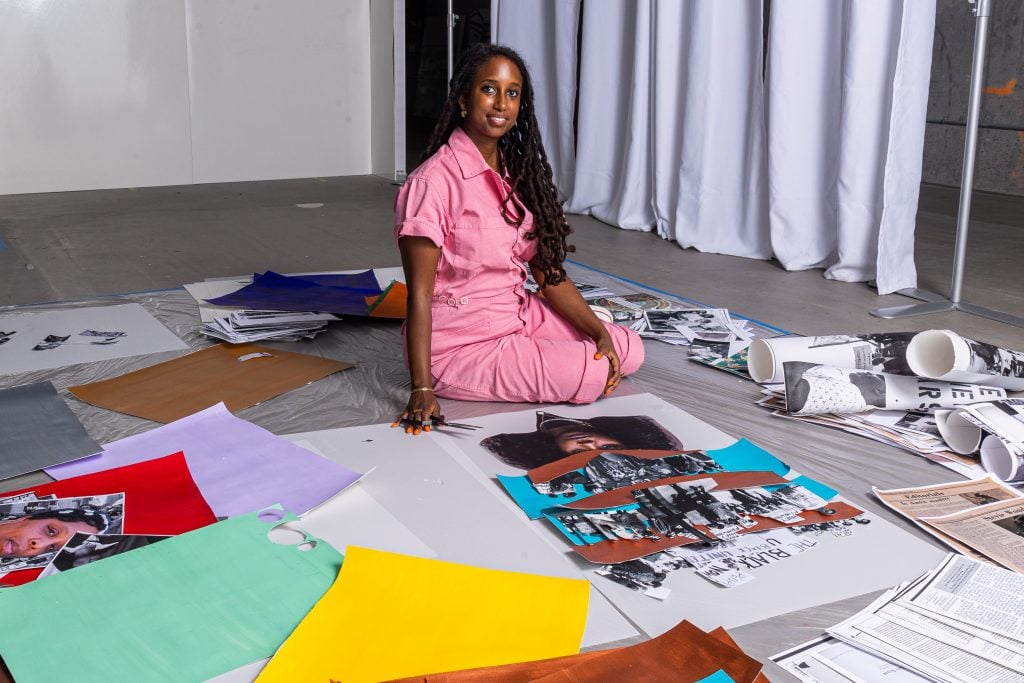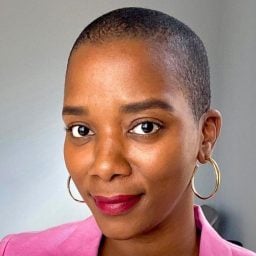This is the third interview in a four-part series by Folasade Ologundudu featuring Black artists across generations who work with social practice. You can read part one, an interview with Linda Goode Bryant, and part two, with Rick Lowe.
Thousands of years of art-historical movements have birthed language to describe and critique works of art in detail. Social practice, however, is in its infancy as an artistic movement—the term has only been in existence for the last half-century. And so it requires a radically different way of evaluating its effectiveness as both an art form and a vehicle for social change.
Artist and professor Helina Metaferia has developed a rubric for community engaged art: what she calls “metrics of integrity.” The key, she explains, is evaluating how the people you work with to create your work feel about the experience. She uses this rubric to inform her courses on social practice at Brown University.
Intrigued by the myriad ways in which she can communicate ideas through art, Metaferia approaches her practice with fluidity, never beholden to one material or mode of expression. Metaferia works not only in performance and social practice, but also in college, video installation, and performance. The through-line is her interest in amplifying the untold histories of people from BIPOC communities, specifically womxn/femme-identifying people.
Metaferia’s interest in political activism was nurtured early. Her parents, Maigenet Shifferraw and Getachew Metaferia, instilled a sense of social justice in her at a tender age. Her father taught political science at Morgan State University, an HBCU in Baltimore, Maryland, and her mother was an Ethiopian women’s rights activist.
Metaferia’s well-known “By Way of Revolution” series began as a tribute to her mother, who passed away in 2016. The series starts with interviews and private performance workshops for female activists, with whom the artist speaks about their lives, inspirations, and struggles. Then, she works with them to pull together imagery that she uses in photography, videos, and assemblages. Uplifting these women enables her to hold space to grieve and celebrate the life of her late mother, while the process creates space to examine the impact of Civil Rights eras of the past on today’s social justice movements.
Late this summer, I spoke with Metaferia to learn more about her activist background, how her work tells the forgotten stories of Black American life, and why making art is an act of healing.
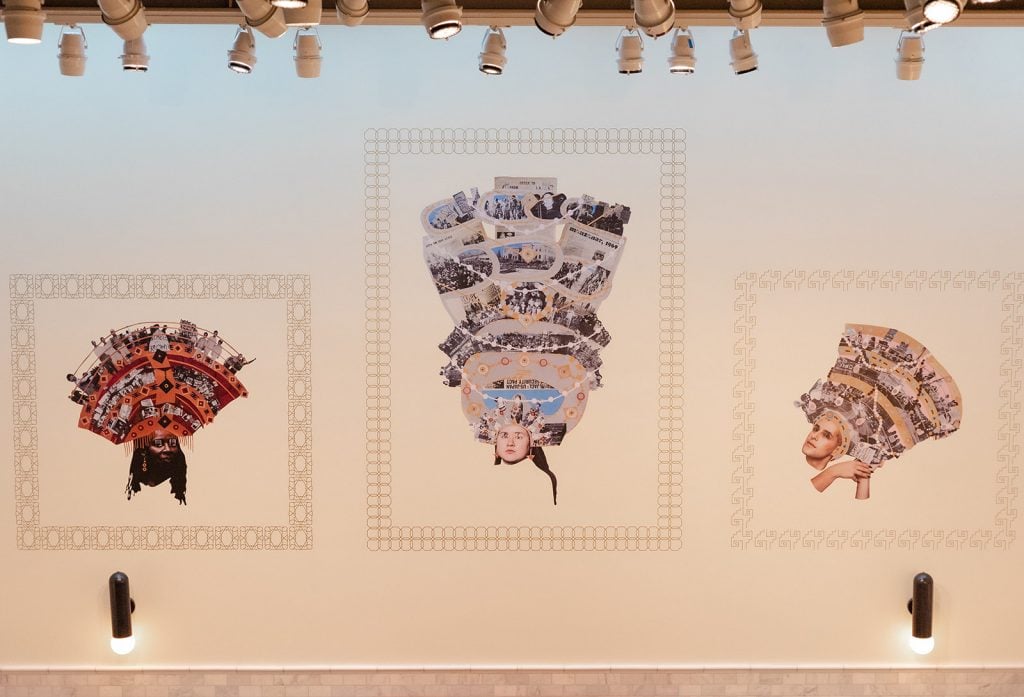
Installation by Helina Metaferia, “We’ve Been Here Before,” currently on view at RISD Art Museum in Providence, RI, through June 25, 2023. Photo by Dee Speaks, courtesy of the artist.
What are some of the core ideas you focus on in your work?
My practice is interdisciplinary. I work at the hybrid of visual art, performance, and social practice. One of the core ideas that I focus on is the notion of belonging, from a citizenship perspective and being connected to one’s country but also how one feels connected to institutions that are supposed to serve the public. I’m interested in opening up my platform to those who have often been marginalized by systems and institutions that operate within white supremacy, oppression, and patriarchy. My practice contains the inquiry of what it looks like to have liberation and freedom and how we can coexist. Does capitalism provide that structure or do we need to work outside of capitalism? I’m thinking about previous liberation movements and drawing inspiration from activist histories to co-create what future generations of liberation look like. To do that, I activate through social practice workshops.
What does social practice mean to you?
Social practice is a new term. It’s only a couple decades old. Before it was considered community art, but the way that we think of it now is relationships as a medium of engagement. I’m interested in practices that bridge the ordinary and make it extraordinary. Some of that could be a relationship—building trust—and then some could be happenings or occurrences that are unexpected, where art takes place in public spheres that are not normally thought of as sites for art.
What are some of the things that initially drew you to art-making?
I’ve been a creative for as long as I can remember. The process of going from novice artist into a more developed practice was something that involved years of training and education but moreover it’s a commitment not just to art as a profession, but as a lifestyle. I say this because being an artist requires a lot of inquiry and curiosity about the world. There’s a lot of contemplation but there’s also this idea that one can intervene, make a statement, or provide a voice for what people are collectively experiencing.
As an artist, I have a lot of practices that don’t involve making an object but instead are tied to process. Whether that practice is movement, research, presence, or attentiveness to my surroundings—that’s part of being an artist. When one is a creative, one is always thinking about how creativity can take place in this moment or with this experience and it’s hard to turn off. I’ve been maturing the visual vocabulary that I have and the way I articulate it over a long period of time. That’s what makes a career, your commitment to your practice and your discipline in practicing it.
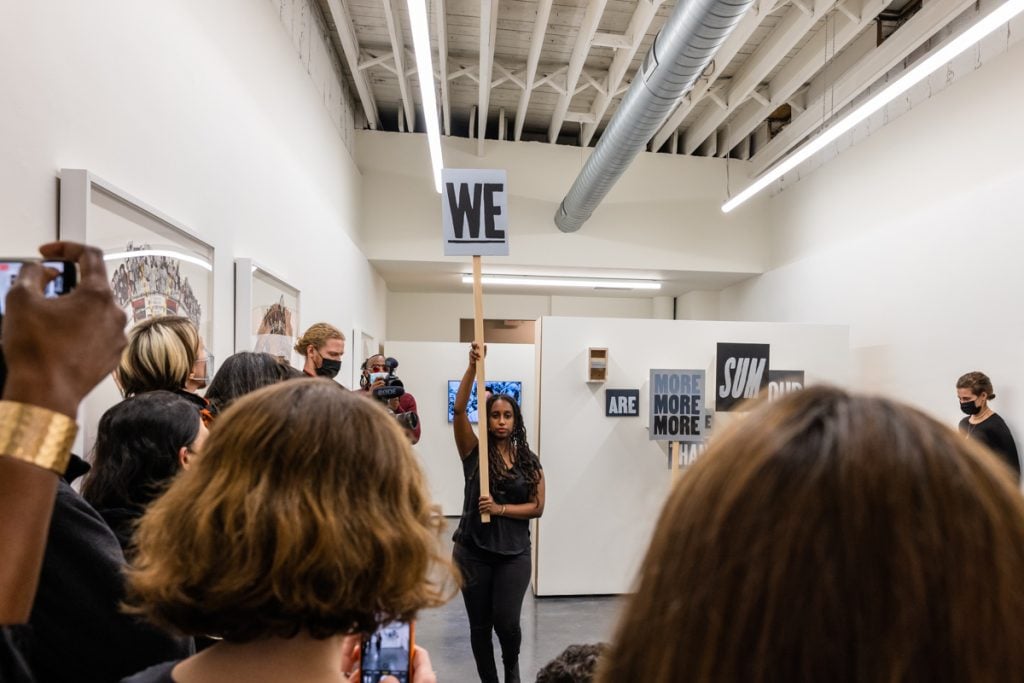
Recent live performance by Helina Metaferia, “The Willing,” 30min, 2022, at Praise Shadows Art Gallery in Brookline, MA. Photo by Edward Boches, courtesy of the artist.
I love that. In your opinion, what is the function and purpose of art?
The function and purpose of art has changed over the course of human history. We’ve always used art as a mode of expression. Those are the primary ways that there’s been evidence left behind that humans have existed, so art becomes artifact. There are so many ways in which art lives: art for commerce, art as a way to elevate class. Then there are also the ways in which I’m interested in art. The function of art for me is actually healing. It’s community healing, it’s personal healing. I believe that within art there’s hope and art can be medicine. I’m familiar with practices in Ethiopian culture where visual art becomes visual medicine. We have a strong tradition. We have art that’s fused with spiritual practices. I’m interested in art that sits within my ancestral memory.
You work across collage, assemblage, video, performance, and social engagement. Tell me more about the various mediums you use to communicate your ideas and your multidisciplinary approach.
I work with a hybrid of mediums because I’m interested in communicating an idea. I find limitations within every medium and when I hit a boundary with the medium, I’ve found flexibility in my practice to maintain the integrity, the research, and the idea—to allow the work to take different forms. So I’m more committed to the idea than the medium and this has allowed me a lot of freedom in my practice. I started my practice like many people, in one medium. I majored in painting in undergrad and I was committed for many years after that.
I am also interested in activism as a performance. I’m interested in the ways in which people galvanize and find social solidarity to instill change. When I think about ways in which I can speak to the legacies of activism, performance or social practice is a very natural medium for me. Those are languages of community organizing. In the same realm, I’ve used the relics of my performances and social practice workshops to make objects. What I love about object-making is it’s a lasting impression. The object allows for the archive to exist.
Do you consider yourself to be a political artist? And if so, what does that mean to you?
All artists are political artists. All artists are working within systems and structures that have become solidified. I overtly address politics within my practice, but I think that even those who try to avoid identity, they too are working very politically, even if it’s from a place of privilege. Their identity is part of the politics of how they’re able to exhibit. I’m thinking particularly of white male abstractionists from the ‘60s and I’m thinking about how they wanted to shift the narrative away from what was happening in the world towards a formal study of art-making. And I thought, well, how political is that, to think of your own experience in the middle of the ‘60s and not think about or respond to the social issues that were happening at that time? My work is overtly political and I think part of that is because I come from an activist family and my father taught political science. I’ve always had this hyper-awareness of the ways in which our existence fits and coincides with governance and policy.
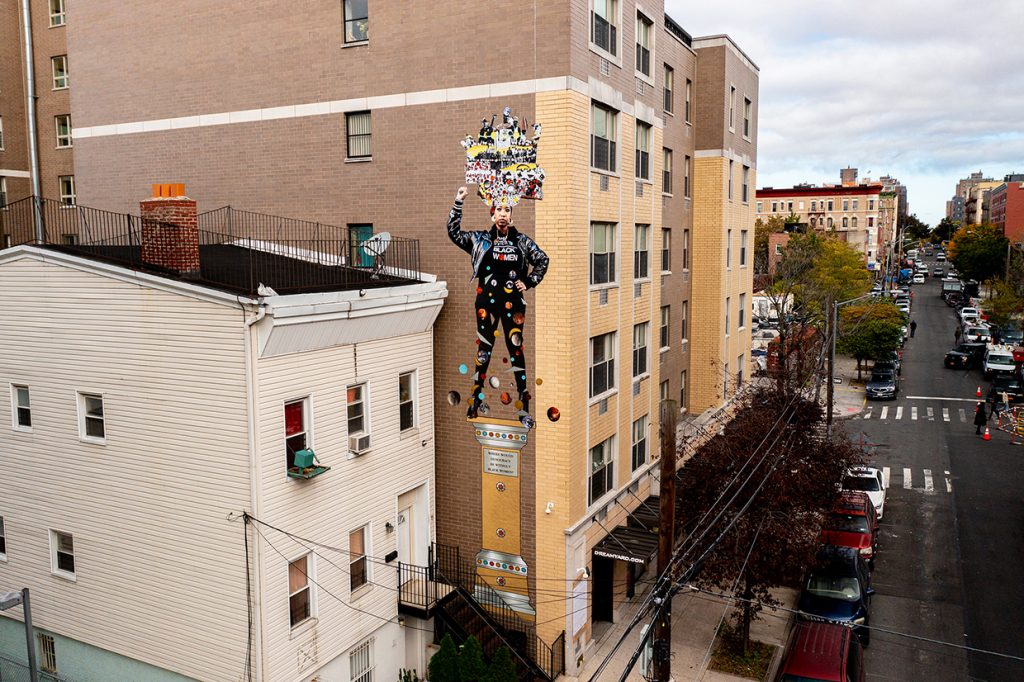
Mural by Helina Metaferia, Headdress 13 (2021), currently on view at Dreamyard Projects in the Bronx, New York. Photo by Ronald Weaver, courtesy of the artist.
Social practice is an art medium that focuses on engagement through human interaction and social discourse. How does your work engage with that idea?
My “By Way of Revolution” series incorporates video, installation, performance, etc. One aspect that people may not see is the social component. I work with people on the front line of activist movements. They become sitters for my collages. I’m sometimes invited by a host institution or organization to do workshops only available and open to BIPOC-identifying folks who also identify as women. The workshops are completely private. We focus on performance as a form of resistance. We do psychosomatic gestures and exercises about how we store trauma in the body and how both joy and trauma are inherited. We look at epigenetics and, for a few hours while we gather, the space becomes very vulnerable and intimate.
Then there’s an interview process, which includes going back and forth with folks from the workshops to accompany them in finding research that’s very specific to how they identify and add images of their families into the collages. Those images then become headdresses, inspired by their ancestral lineage or something that they’ve said in the interview. I recently did this in advance of my current project that’s up at the RISD [Rhode Island School of Design] Art Museum, and my recent solo exhibition at Museum of Fine Arts, Boston. Through family photos and protest archives from local libraries, we’re looking at generations of local communities.
I’m a professor at Brown, which is across from the RISD Art Museum, and a lot of those spaces at Brown were built by slaves. I’ve come up with a system in which something incredibly private can take place, which is the social practice workshops, and then the public-facing component, whether it’s the public art project or the artwork displayed in the interior of the museum. That part is incredibly performative. It is intended to create an aesthetic that uplifts and celebrates the Black and brown bodies in that community and provides representation.
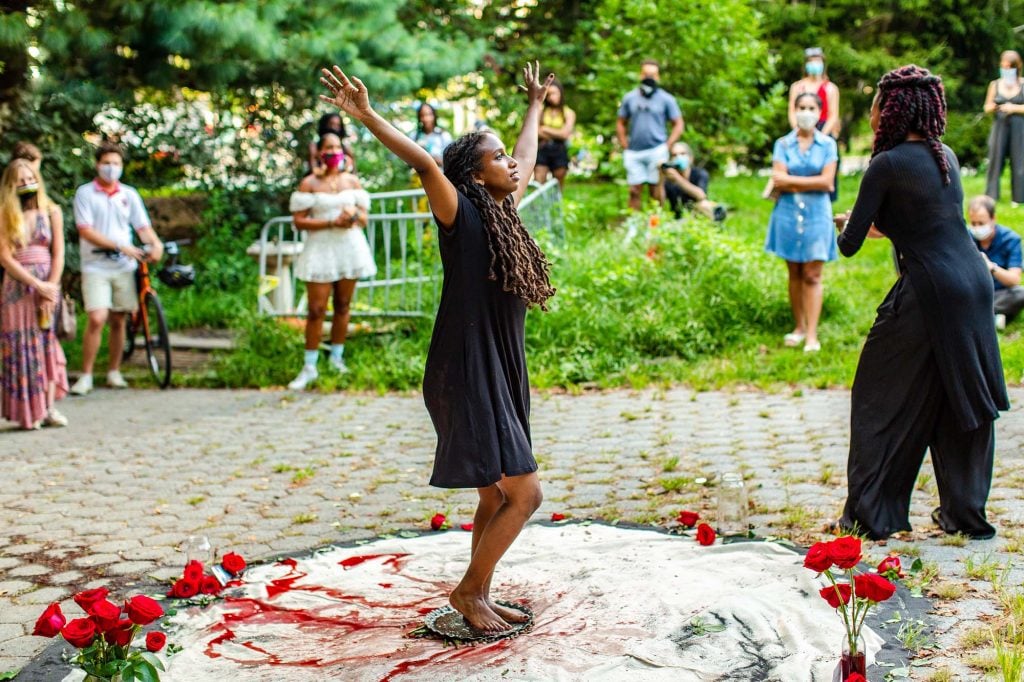
Live performance by Helina Metaferia, For Us” (2020) at a Wide Awake event at Grand Army Plaza in Brooklyn, NY. Photo by Benjamin Lozovsky, courtesy of the artist.
How do you see your public work relating to the private work?
My work is based on ritual. It can take the form of performances that are private. Privacy offers an ability to experiment, to take risks and explore without judgment or scrutiny. So often, the inner critic can come up in ourselves and it becomes very difficult to try new things. I’m interested in performance that isn’t a performance and that often comes through when there isn’t the burden of the gaze. Then there is performance that is public, staged, or constructed—sometimes through sculpture, installation, or video art.
The reason I’m interested in the private and the public is because a lot of my work is influenced by Ethiopian art forms that are ritualistic and about healing. Whether it’s through a religious or spiritual lens, objects act as an intermediary between the divine and the earth, the human. That tradition of Ethiopian art is also evidenced not only in other African art forms, but other art forms all over the globe.
In a text message, you mentioned to me the idea of “metrics of integrity” as criteria for evaluating social practice. Can you expand on that?
I teach social practice at Brown University and one thing that we often talk about when I look at a student’s work is, how do we evaluate this project? Because usually an evaluation of a visual art project is through the aesthetic, the object itself. We think about form or color. But what are the metrics for social practice?
Oftentimes to know if something is good or not, a part of the metric is, do the participants feel exploited or do they feel equal agency? What are the power dynamics in the project? That, to me, lends itself to this idea of integrity. I’m very keen on thinking through how the participants in my projects are not simply pawns for my art or career—they need to feel like they are an equal maker. I want people to feel like the work speaks to them as people, even though it’s through my lens, and that their participation isn’t something taken for granted. So when I think of integrity, I’m thinking about the ethics around having participants in my work. Is there a way to make work that’s mindful of people as the medium in social practice? How can we make sure that we’re not being extractive in the ways that capitalism can be and the way that institutions can be, and the way that this modern world has trained us to be?
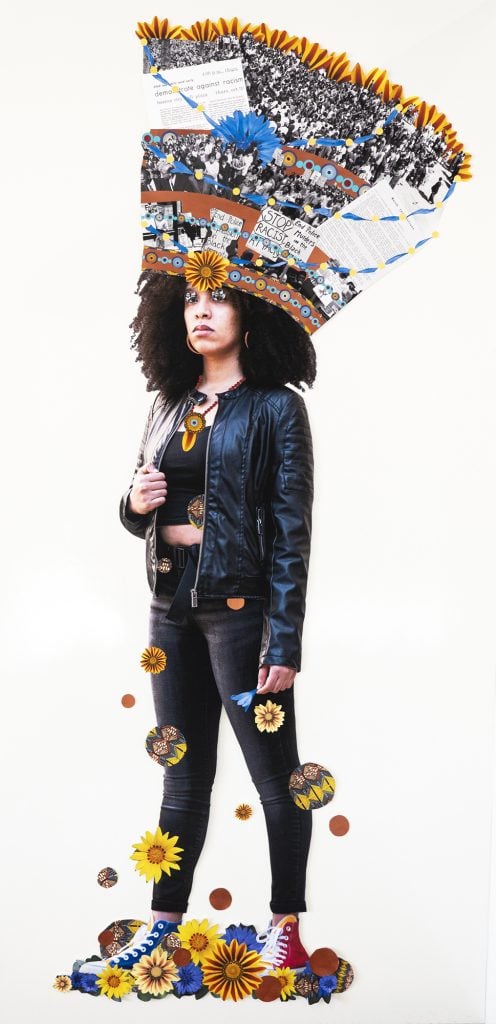
Mixed media collage by Helina Metaferia: Headdress 30 (2021). Photo courtesy of the artist.
I’d love to learn more about your thoughts on the role of the institution and the market when it comes to socially engaged art and how art sales are influenced by both.
Since social practice is now taught in art schools and found its way into academia, institutions have become very curious as to what artists who are socially engaged do; they often fit them into programming and education. It’s not as viable in the market, but artists who are socially engaged also have their hands in the market. Other non-profit spaces are also thinking about socially engaged art. When you’re working within the art-world context, you have to navigate all of these different spaces. I have a responsibility to my participants and their stories, so I navigate this space very intentionally. There’s a lot of rigor in the work and I don’t want that to become diluted if it’s in an art fair, or in some sort of commercial context where the emphasis really is on what’s shiny and new. But I also don’t want to be pigeonholed into this academic sphere where it doesn’t have any relevance outside of a small group.
In many ways, social practice is contrary to a lot of what capitalism supports because it’s not about greed and commerce. Social practice art, done well, can be very slow. It can take years. I think what social practice does offer is a record almost counter to a lot of what the art world values, which is individualism and the individual genius artists. It’s about pointing attention to the collective and the community.
